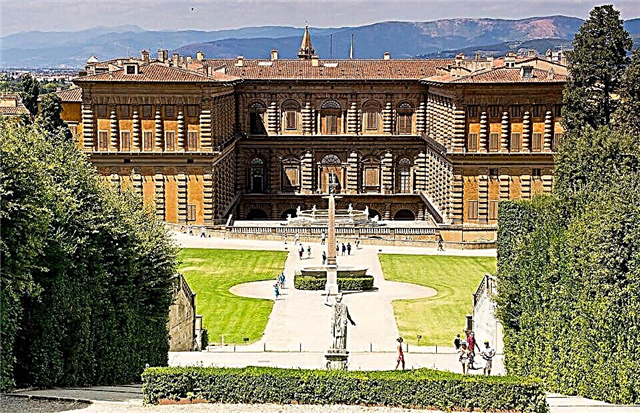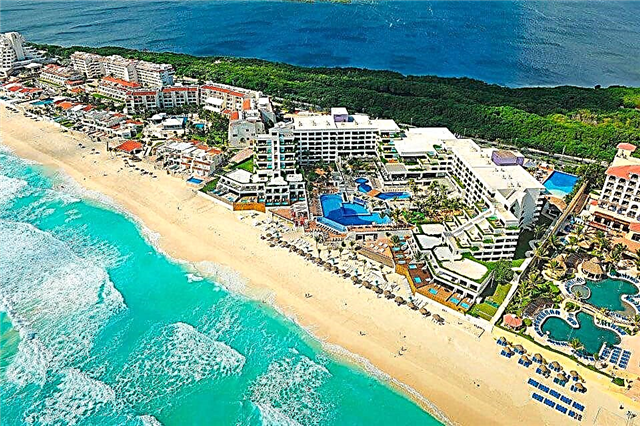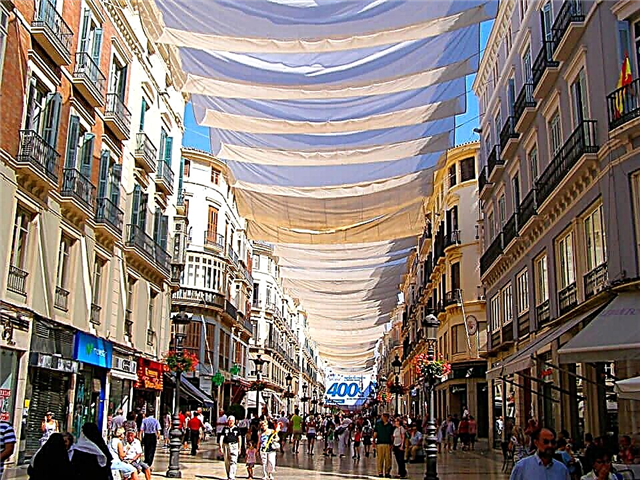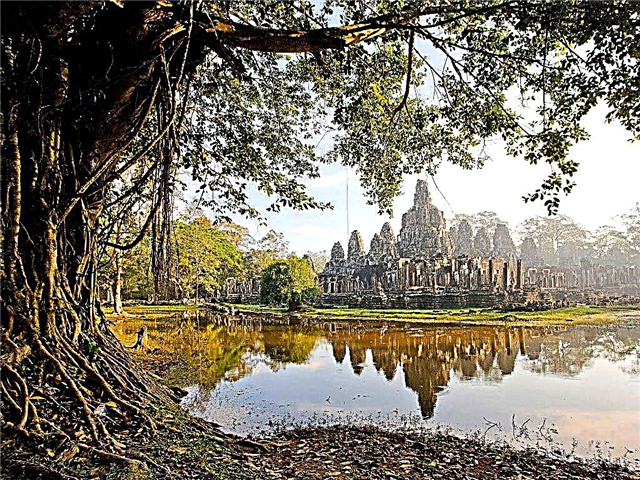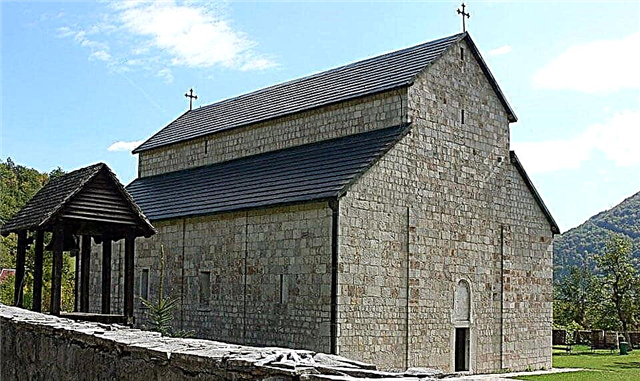The crystal clear Adriatic Sea, mountainous landscape, picturesque valleys, comfortable climate make holidays in Montenegro popular for people of all ages. There are no communication problems (minimal language barrier), the infrastructure of the resorts is well organized (rest there is possible at any time of the year), a huge number of architectural sights of the country available for inspection. Among them, in the first place are the famous temples and monasteries of Montenegro, hidden in the thickets of luxurious greenery of rare plants, shrouded in the atmosphere of ancient legends, secrets of Montenegro.
Ostrog monastery

Tourists and pilgrims go to the main attraction of Montenegro in an endless stream. In a rock at an altitude of 900 m above sea level, the monastery of the wonderworker Vasily of Ostrog is hidden (his relics are the greatest shrine in the world of the Orthodox Church). It has long become a haven for people who believe in help, the fulfillment of the most secret desires by the miraculous power of the Holy One.
In a place filled with prayers of special energy (next to a holy source, miraculous relics), they find help in solving problems and troubles that have arisen. A sacred place appeared in the middle of the 17th century. Ostrog consists of two parts: the upper (older) part and the lower part, created in the 19th century. In the lower zone there is the Church of the Holy Trinity with the relics of a 12-year-old boy - martyr Stanko.
The parts are separated by a steep path, about 5 km long, and you can cover the distance (going uphill) along a special path in 30 minutes. Before the appearance of Vasily Ostrozhsky, hermit monks lived here in a cave hidden from the eyes of people. Gradually, two churches appeared in the sacred place: Holy Cross, Vvedensky (Introduction of the Most Holy Theotokos). In the last place the Great Miracle Worker, who died in 1671, prayed. His relics (in the role of the main shrine of Ostrog) are kept in a small cave of the Vvedenskaya church.
Cetinje monastery

The architectural and historical ensemble of Montenegro is the political and cultural center of the country. Here, on the site of Zeta (an ancient South Slavic principality that existed on the site of modern Montenegro) in 1484 a monastery was erected, which existed until the destruction by the Turks in 1692. The new building was destroyed several times, restored and was the residence of the Metropolitan of Montenegro in its ancient capital - the city of Cetinje, located at the foot of the Eagle Cross Mountain.
During the Middle Ages, the buildings served as a powerful fortress. It was surrounded by a moat with water and stakes, and fortified with loopholes. Now you can see part of the brick walls of the fortress. On the historical territory there are the Palace-Museum of King Nikola, the Church of the Nativity of the Blessed Virgin Mary.
The remains of the king and his wife Milena, gifts from the emperors of Russia, a valuable collection of printed publications of the 13-19 centuries are kept here. The first printing house of Montenegro worked here. The country's first high school opened in 1880 within the walls of the building. The famous works "Octoechos five-eyed", "Psalter", "Prayer Book", "Four Gospels" are among the protected shrines. Keeps one of the richest collections of relics of the Orthodox Church.
Moraca monastery

One of the main Orthodox monuments of the Middle Ages in the Balkans is an architectural complex consisting of the building of the Cathedral of the Assumption of Our Lady, a small church in honor of St. Nicholas and living quarters for monks. It is located along the right bank of the Morac Canyon in a beautiful mountainous area. All tourist routes try to include in their programs a visit to this extraordinary place.
The majestic, one-nave, cylinder-shaped soda building was erected in 1252 from soft tuff covered with plaster. Of the numerous frescoes (the technique of fresco painting of the 13th century has no analogues in beauty), created under the leadership of Stevan (the son of the Serbian king). His grave is located at the local churchyard.
Now from the interior decoration 11 scenes have been preserved, connected with the life of the prophet Elijah. The main work on the restoration of the destroyed architectural treasure was carried out in the 18th century by the artists of Montenegro. The exact time of the construction of the small church of St. Nicholas is not precisely determined: the monks consider it to be more ancient than the cathedral. Of interest is the interior decoration made of ancient frescoes.
Piva monastery

Among the 1600 church sights of the country, there are large, small ones, included in tourist routes, almost forgotten. You can see them on your own or together with local excursions. Such a building, called a symbol of the invincibility of the inhabitants of the country, is located near Pluzine in the northern part of Montenegro. In the 16th century, in the middle of a pine forest near the Pivsky Oka, an ordinary house with narrow loopholes appeared, which did not attract the attention of the Turks.
Later (after the construction of a hydroelectric power station on the Piva River), the building was moved 2 km higher. A guest house (konak), a bakery, and a cemetery have been preserved in the same place. Here they provided assistance to the rebels, sheltered the rebels, negotiated with representatives of the Christian world. The building was built of stones of gray, pink shades. It has large dimensions: height 13m, length 23m, width 15m. The exterior of the building did not make enemies want to rob it.
Inside the room there are many old frescoes, an iconostasis covered with gold with a huge cross. A large number of manuscripts, paintings, books, and jewelry are also kept here. One monk lives here permanently. He keeps order, controls the bells, which are not on the roof of the main building, but under the roof of a separate extension. It is proposed to come to the center of spiritual life of Herzegovina (now the active monastery belongs to the Serbian diocese) by boat on Lake Piva.
Church of the Resurrection of Christ in Podgorica

For a long time, there was no main Orthodox church in the country. Since 1993, the first stone has been laid in the future huge building, striking in size, splendor of decoration, and design. The beginning of the construction took place in the presence of Patriarch Alexy II. The author of the project was the architect Peja Ristic. The building belongs to the neo-Byzantine style. It included many new architectural elements. The height of the two levels of the cathedral is 41.5 m, the belfry is made of 17 bells (2 were brought from Voronezh), 7 crosses, sparkling with gilding.
The monumental appearance of the building is formed by huge stone blocks, decorated with antiquity. The interior decoration is distinguished by an abundance of images made of small pieces of granite and marble. Mosaic "Noah's Ark", fresco over the entrance measuring 53.5 m 2... One of the largest churches in Europe can simultaneously accommodate up to 5 thousand believers.
Daibabe monastery in Podgorica

At a distance of 4 km from the capital of Montenegro, there is an amazing place hidden in rocky caves. You can find it in a small building dedicated to the Dormition of the Most Holy Theotokos with bell towers on the sides. The main rooms are underground, in caves arranged in the shape of a cross. Local legends say that as early as the 3rd century, the first Christians were hiding in the catacombs with their own water source. The monastery appeared in 1897 and the miracle worker Simeon Daibab became its first abbot (his relics are kept here).
The first liturgy was sung in the cave church in January 1897. The cave used is 20 m long and about 3 m wide. Chapels are hollowed out on the side walls, and an altar is located in the center. The ceiling and walls were painted by Simeon, his followers.The surviving frescoes are of great value. In an atmosphere of silence, peace, numerous pilgrims receive relief, hope for a favorable solution to their problems.
Cathedral of St. Tryphon in Kotor

The old building is depicted on the coat of arms of the city of Kotor. Saint Tryphon, who followed the path of Jesus Christ, is considered the patron saint of the city. The cathedral in his honor was founded in 1166. Earlier on this place there was a church built in 809 by a noble citizen Andriy Saracenis. It was he who bought the relics of St. Tryphon ay of the merchants of Venice.
The devastating earthquake of 1667 required the cathedral's bell towers to be rebuilt. They are made in the form of high towers (up to 35 m high) from a special stone brought from the island of Korcula. There is a window in the shape of the famous "rosette" above the entrance. The ancient frescoes of the interior are poorly preserved. But even now, under the age-old layers of plaster, lime on the apses, the vaults of the naves, fragments of Byzantine-style murals are revealed.
The exact time, the author of their writing, remains a secret of the cathedral. The origin of the rare wooden crucifix found in the church is also unknown. The main shrine of the Cathedral is considered to be the relics of St. Tryphon. The body of Andria Saracenis rests in the sarcophagus to the right of the entrance. The cathedral, as a preserved example of the Romanesque architecture style, is a World Heritage Site.
Church of St. Luke in Kotor

A modest, unobtrusive temple, standing in the historical part of Kotor, is in fact a famous landmark and the oldest church in Montenegro. It was erected in 1195 at the expense of the wealthy feudal lord Kazafragi (this is evidenced by the memorial inscription). There are two altars in the current church: Catholic and Orthodox), which is rarely found in churches of the world. The two branches of the Christian religion lived here peacefully, in harmony. The main shrines of the cathedral are particles of the relics of St. Luke, the martyrs Orestes, Mardarius, Auxentius.
Among the interior decoration, fragments of ancient frescoes by Italian and Cretan masters of the 17th and 18th centuries have been preserved. In a small chapel belonging to the church, there is a unique iconostasis depicting Christ in the image of the Tsar. The temple opens on holidays, before planned excursions, wedding ceremonies, baptisms. An interesting fact is the burials of local residents inside the building. Its entire floor consists of gravestones. During the strongest earthquake in 1979, this church was the only building that was not damaged.
Church of St. Nicholas in Kotor

On the Grets Square in the old center of Kotor, a relatively young cathedral rises, erected in honor of the patron saint of travelers, sailors, St. Nicholas. Historically, the existence of a Dominican monastery in this place is confirmed, turned into a soldier's barracks for Napoleon's army. After that, a church was erected here from the destruction, the life of which was cut short by the fire of 1896. A new church was erected on its foundation in 1909.
The building corresponds to the pseudo - Byzantine architectural style. There are two high bell towers at the entrance. Among the interior decoration, the iconostasis of a three-meter height, created in 1908 by the Czech artist Ziegler, stands out. The treasury of the beautiful building contains many valuable documents, icons, art objects, and clothing. The most interesting are the icon "Three-handed", the book "Sacrifice of Abraham in 1899", the image of St. Nicholas the Wonderworker in the form of a mosaic located at the entrance. In the courtyard, you can use the spring with healing water. Services are held daily.
Church on the island of the Virgin

The history of the creation of an ancient church on a reef, which was turned into an island by an original construction method, attracts numerous tourists every year to the city of Perast. The Mother of God, who lives on the reef, patronizes local sailors. As a token of gratitude, the locals regularly hold the festival of fascinada here. On decorated boats, they sail around the island three times and throw stones into the water, fortifying the shore.
In such a strange construction method, for almost two centuries, stones were collected on sunken ships and reefs, a stable platform was formed. An ancient landmark of the country, a church, has grown on it. The first floor of the building is decorated with icons, paintings by artists of the 17th century, an organ sounds 300 years old. The altar is made of four types of valuable snow-white marble and is decorated with the image of the face of the Holy Mother of God. The interior is illuminated by a chandelier made of real Murano glass, made almost 3 centuries ago. In the archaeological museum, you are invited to see ancient exhibits: Roman crosses, a fountain, silver roots.
Lifting mechanisms, lanterns, bells and other items belonging to ships of different countries at many times. On the second floor there are amazing ancient amphorae, jugs, mysterious captain's chests. A collection of paintings depicting ships, an olive stele of the Diva that adorned the bow of a ship in the Middle Ages. Among them is a unique icon of the Holy Mother of God, embroidered by a woman from Perast, who had been waiting for the return of her sailor husband for 25 years. Thousands of plates (gold, silver, bronze) are embedded in the walls of the building. They were donated by sailors (the custom still exists) in gratitude to the Mother of God for a successful voyage.
Cathedral Church in Bar

A magnificent building was built on the site of a 16th century building in 1863. The last renovation was carried out in 2016. The cathedral is consecrated in the name of the first ruler of Montenegro, Jovan Vladimir, who died as a martyr on the cross. The snow-white architectural creation is adorned with three golden, sparkling domes. They are trophies taken during the Austro-Hungarian occupation in 1918. All bells, cannons, cannonballs were melted down and new ones were made. For the past several decades, the cathedral has been the main Orthodox church in the city.
A beautiful-looking monolithic stone (red limestone) was used to make the walls. On the facade there is a window in the form of a "rosette-rose". Inside the cathedral, frescoes with images of the Saints have been preserved. The cathedral temple is called the largest religious building in Montenegro. Its height is 41 m, area 1200 m2... Services are held daily. In a special room of the amphitheater, events are held for the cultural and spiritual development of the population.
Monastery Gradiste

In 1116, the construction of Gradiste began on the site of ancient buildings (Gradzhevine) and an old Greco-Roman cemetery. It became a monument of fresco painting of the Middle Ages in Montenegro. The surviving ensemble includes a cell building, the ruins of a protective wall, a cemetery, and buildings of three churches.
Among them:
- Saint Sava. A one-nave building of alternating rows of white and red stone and a belfry with three bells. The iconostasis was painted by Nikolai Aspiotis in 1864.
- St. Nicholas. Built in the XII century, painted by a fresco master from Budiml. Among his creations is the fresco "Mammal" (patroness of young mothers). In ancient times, gifts of mothers who did not have breast milk were left next to her. The luxurious carved iconostasis appeared here in 1796.
- Assumption of the Blessed Virgin Mary. A small building is located on the upper landing next to the cemetery. The frescoes depict saints from the Nemanich family.
The buildings suffered greatly from destruction during the invasion of the Tatars, the French, during the 1941 war, from a severe earthquake.
Monastery Podmaine in Budva

Historical facts speak of the emergence of a Christian structure at the foot of Mount Ostrog or in an area called Maina, approximately during the reign of the Nemanich dynasty. For a long period of time, the residence of the country's metropolitans was located here.Within its walls, Njegos wrote a literary work "Mountain crown", which became a literary monument of Montenegro. The buildings were given new life by the modern restoration and opening of the complex in 1995. The complex includes two churches dedicated to the Dormition of the Most Holy Theotokos.
The large building was renovated in 2000. The icon painter recreated the scenes of the Last Judgment, placing among the sinners the image of the leader of the communists of Yugoslavia Broz Tito. The small church (4 m long and 2.5 m wide) represents the catacombs of the first Christians and is located under the cells. The building was built in the XII century. A stone cistern with water is installed in the center. She is famous for amazing stone carvings. The room has an inscription indicating that the last restoration took place in 1630.
Dulevo monastery

There is a written mention of a building that appeared in honor of the soldiers of Tsar Dushan in the middle of the 16th century. The novices of the Parish of Dechany moved here after the haircut. The building was often destroyed by wars, natural disasters. It has now been fully restored. On the walls of the southern and northern sides, you can see traces of former buildings, a cell building with narrow windows in the form of loopholes, a belfry with a bell. Fragments of two layers of ancient painting, original frescoes, have been preserved inside the old building.
They depict scenes from the lives of the saints and are a source of pride. The vault of the room is decorated with compositions highlighting important evangelical events: Meeting, Christmas, Crucifixion. It contains six medallions depicting Christ, Our Lady of Oranta, and saints. In the upper part of the building there are two cells (in them Saint Sava worked before his journey to the Holy Mountain).
There is a spring (Savvina's water) on the territory, which helps pilgrims to treat stomach ailments. According to legend, the soldiers of Tsar Dushan were healed of typhoid fever with this water. Here you can also see an old oak tree under which Saint Sava was sitting. The complex is located on a plateau above Sveti Stefan.
Praskvitsa monastery

High in the mountains, near the settlements of Sveti Stefan and Przno, not far from a stream smelling of peaches (hence the name of the building), there is an ancient monastic monastery. The religious shrine of Montenegro appeared in 1059. After brutal destruction, a new stage in her life began in 1844. The new Church of St. Nicholas (originally built in 1413), together with the Church of the Holy Trinity and monastic cells, are part of the architectural ensemble, which is a landmark of the country.
Together with the excursion, you can sit at a stone table, where the council of elders made the fateful decisions of the Middle Ages. Visit the treasury museum. It contains a valuable collection of icons, ancient art items, ancient weapons. Handwritten books (among them the Gospel of the 16th century), documents of the Pashtrovich era, an old monastic seal, the golden cross of Dushan. The cells contain a valuable library with a total of over 5000 books.
Rustovo monastery

The current monastery for nuns is home to 8 sisters. They serve the buildings that make up the monastery ensemble. Today it includes the construction of three temples. In 2003, a monastery was founded on the site of the ancient church of the Assumption of the Blessed Virgin Mary (erected in the XIV century, destroyed by fires, an earthquake). His consecration took place on Epiphany Christmas Eve. Until now, you can see the preserved foundation of the ancient structure.
During the construction process, the remains of the 14th century pashtra martyrs were found. Archbishop Amphilochius laid the foundation of a small cathedral in 20005, dedicated to the members of the Romanov family who were martyred. The remains of the sufferers of the XIV century were first placed under the altar of a large church, and then buried in the foundations of the Romanov temple.
The third temple (paraklis) is located in the cell building. It is dedicated to the famous saint of the 6th century, who founded a large number of churches. Located next to the Chelobrodo hill. It offers a panoramic view of the most beautiful part of the Adriatic Sea in Montenegro.
Church of the Archangel Michael in Herceg Novi

The Orthodox Church, which is just over 100 years old, is considered the pearl of the Montenegrin region. It stands in the center of the old quarter, on Stefan Vukmcha Square in Herceg Novi. The unusual architectural style is associated with the participation of several architects in its construction. Each of them expressed their preference for Romanesque, Byzantine, Gothic, Baroque, Islamic architectural heritage. All elements have harmoniously blended and formed a unique appearance of the building.
The interior decoration is striking in its exquisite beauty. The altar and the iconostasis were made by the master Bilinich from beautiful, rare marble. Many icons are considered rare and unique. They were painted by the Czech artist Ziegler. The local library contains a large number of church books, including those from Russia. The building is surrounded by majestic palm trees. In the beautiful square there are many cozy cafes, places for rest, observation of the temple.
Church of the Savior in Herceg Novi

Behind a high stone fence on the central street (Njegosheva) there is an old temple complex consisting of the churches of the Savior and St. George. The first was built in 1713 from boulders brought from the island of Croatia. It received its final appearance in 1864 as a result of a complete restructuring, starting from the foundation. In the middle of the next century, an interesting iconostasis, a belfry with three bells, appeared in the building.
Among the numerous decorations of the interior, there are several Russian icons. The Church of St. George was built at the end of the 17th century. This place used to be a Turkish mosque. The main shrine is considered to be a round icon depicting Saints Peter and Paul. The archives contain old books, icons, church dishes made of silver. Behind the fence there is an old cemetery, a two-story building of the residence of bishops from the 1700s, a school where the future famous poet and priest of Montenegro, Njegos, studied.
Savina monastery

The operating complex (it is home to 10 monks), surrounded by a garden with numerous exotic plants, is the center of Orthodoxy among the settlements along the Boka Kotorska Bay. It was named after the first archbishop of Serbia, Saint Sava. The complex includes three buildings: Small Assumption, Big Assumption and the Church of St. Sava (it is located next to the upper cemetery). The Small Cathedral (10 m long and about 6 m wide) was built in 1039.
The main preserved value is the ancient frescoes made in the Byzantine and Gothic styles. At the end of the 18th century, under the leadership of the Venetian architect Nikola Foretich, the Great Church was erected in the luxurious Baroque style. The iconostasis of the 18th century has survived, consisting of separate zones created in the traditions of the Orthodox style of the East.
Sacred relics are considered to be a crystal cross belonging to Savva and decorated with rubies, the relics of Queen Helena, George the Victorious, the shroud of 1642. A collection of icons, a library containing over 5000 rare manuscripts, a handwritten Gospel. The Church of St. Sava was built by him in the 1230s. It is now used as a parish church for a male monastery.
Banya monastery in Risan

The active nunnery, founded in the 15th century, is located on the shores of the Risan Bay. In ancient times, there were Roman baths, which gave the name to the new building. In the 17th century, on the foundations of an ancient medieval fortress, a temple was erected in honor of St. George the Victorious. Particles of the relics of the great martyr are the main shrine. The existing appearance was created during the restoration in 1729, carried out at the expense of wealthy sailors of the region.
Now you can see here old icons, clothes used during religious rituals.It is skillfully embroidered with silver, gold threads and decorated with gems. Many faces of the saints are made by old embroidery techniques. The library archive contains a large amount of church literature. It is allowed to visit the inner premises along with the excursion, groups of pilgrims, provided that the established dress code is observed and all the rules are observed.


